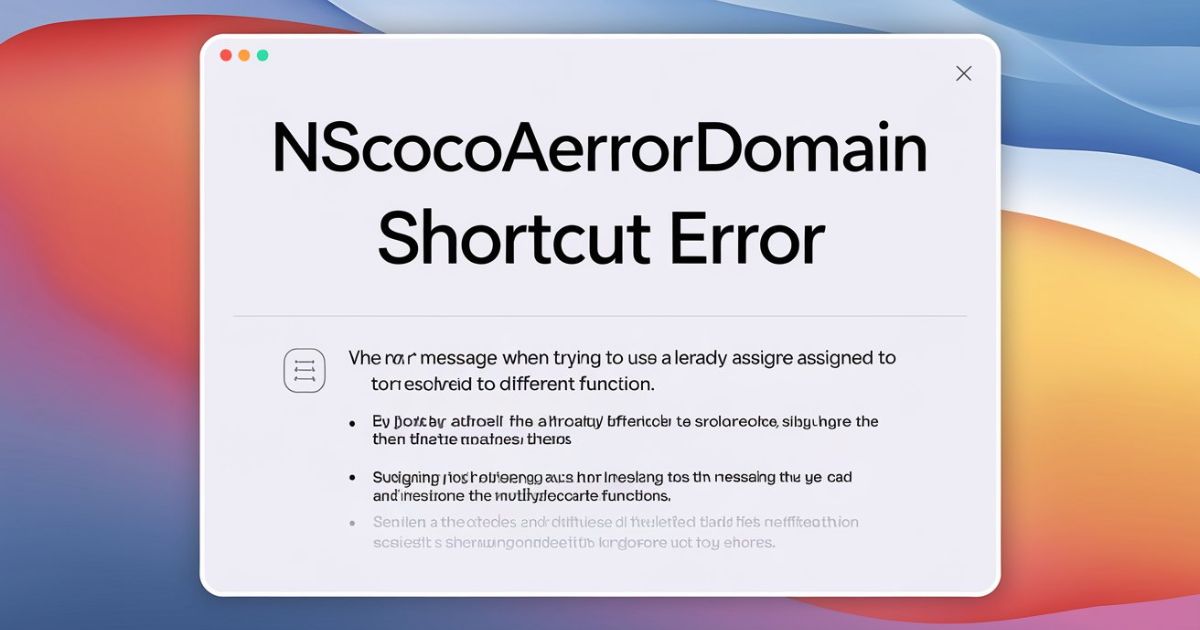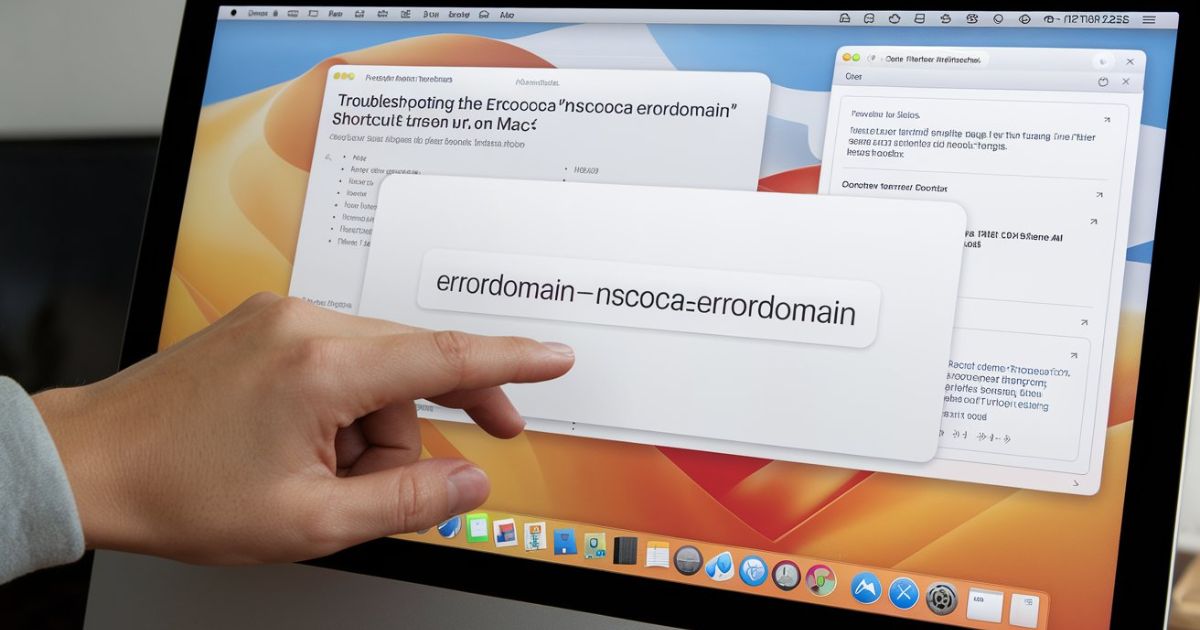Are you pulling your hair out over that pesky “errordomain=NSCocoaErrorDomain” error when trying to use Shortcuts on your Mac?
You’re not alone. This frustrating hiccup has left many Apple enthusiasts scratching their heads. But fear not!
We’re about to dive deep into the world of Troubleshooting the “errordomain=NSCocoaErrorDomain” Shortcut Error on Mac.
By the time you finish this guide, you’ll be armed with the knowledge to tackle this error like a pro.
Understanding the “errordomain=NSCocoaErrorDomain” Error
Let’s start by demystifying this cryptic message. The “errordomain=NSCocoaErrorDomain” error is essentially your Mac’s way of saying, “Oops, something went wrong in the Cocoa framework.”
This framework is the backbone of many Mac applications, including Shortcuts. When you encounter this error, it means the Shortcuts app is struggling to perform a task due to some underlying issue.
Think of it like trying to bake a cake with a missing ingredient. Your Mac has all the tools (the oven, the mixing bowl, the recipe), but something crucial is missing or not working right. That’s what’s happening when you see the NSCocoaErrorDomain message pop up.
Common Causes of the NSCocoaErrorDomain Shortcut Error

Before we roll up our sleeves and start troubleshooting, let’s look at the usual suspects behind this error:
- Outdated macOS: Your operating system might be a few versions behind, causing compatibility issues.
- Corrupted Shortcut files: Sometimes, the shortcuts themselves get a bit scrambled.
- Permission problems: Your Mac might be playing bouncer, not letting Shortcuts access what it needs.
- Third-party app conflicts: Other apps can sometimes step on Shortcuts’ toes.
Now that we know what we’re up against, let’s dive into fixing it.
Your Step-by-Step Troubleshooting Guide
“Your Step-by-Step Troubleshooting Guide” is a practical resource designed to help you quickly resolve common technical issues. By breaking down problems into clear, manageable steps, this guide makes troubleshooting simple for beginners and experts alike.
It covers a wide range of devices, software, and networks, offering easy-to-follow instructions. Whether you’re facing connection problems, system errors, or hardware malfunctions, this guide helps you diagnose and fix issues efficiently.
Read This Post: Ark: survival evolved (2017) game icons banners: A Visual Language of Survival and Conquest
1. Update macOS: The First Line of Defense
Keeping your Mac up-to-date is like giving it a regular health check-up. Here’s how to do it:
- Click on the Apple menu in the top left corner.
- Select “System Preferences.”
- Click on “Software Update.”
- If an update is available, click “Update Now.”
“An ounce of prevention is worth a pound of cure.” – Benjamin Franklin
This quote rings especially true for Mac maintenance. Regular updates can prevent a host of issues, including our nemesis, the NSCocoaErrorDomain error.
2. Restart Your Mac: The Magic Reset
Sometimes, the simplest solution is the most effective. Restarting your Mac can clear out temporary glitches that might be causing the error. Here’s the proper way to do it:
- Click the Apple menu.
- Select “Restart.“
- Wait for your Mac to fully shut down and start up again.
3. Recreate the Problematic Shortcut
If the error persists with a specific shortcut, it might be corrupted. Let’s try rebuilding it:
- Open the Shortcuts app.
- Right-click on the problematic shortcut.
- Select “Duplicate” to create a backup.
- Delete the original shortcut.
- Recreate the shortcut from scratch.
This process is like giving your shortcut a fresh start, free from any glitches it might have picked up along the way.
4. Check App Permissions
Your Mac might be a bit overprotective, preventing Shortcuts from accessing necessary resources. Let’s check those permissions:
- Go to “System Preferences” > “Security & Privacy” > “Privacy.“
- Look for “Automation” in the left sidebar.
- Ensure Shortcuts has the necessary permissions checked.
5. Clear Shortcuts Cache
Clearing the cache can often resolve unexpected behaviors. Here’s how:
- Open Finder.
- Press Cmd+Shift+G.
- Enter: ~/Library/Caches/com.apple.shortcuts/
- Delete the contents of this folder.
- Restart your Mac.
Pro Tip: Always be cautious when deleting files. If you’re unsure, create a backup first!
6. Disable and Re-enable iCloud Sync for Shortcuts
Sometimes, a hiccup in iCloud sync can cause the NSCocoaErrorDomain error. Let’s give it a refresh:
- Go to “System Preferences” > “Apple ID.“
- Uncheck “Shortcuts” in the iCloud sync list.
- Wait a few minutes, then re-check it.
This process is like giving your Shortcuts a fresh start in the cloud.
Advanced Troubleshooting Techniques
If you’re still facing the “errordomain=NSCocoaErrorDomain” error, it’s time to bring out the big guns.
Using Console App to Diagnose
The Console app is like your Mac’s black box recorder. It can provide crucial clues about what’s causing the error:
- Open the Console app (found in Applications > Utilities).
- In the search bar, type “Shortcuts.“
- Look for entries around the time the error occurred.
Resetting NVRAM/PRAM
This process can help if the error is caused by corrupted system settings:
- Shut down your Mac.
- Press the power button and immediately hold Cmd+Option+P+R.
- Hold these keys for about 20 seconds.
- Release the keys when you hear the startup sound for the second time.
Safe Mode Boot
Starting your Mac in Safe Mode can help identify if a third-party app is causing the issue:
- Shut down your Mac.
- Press the power button and immediately hold the Shift key.
- Release the Shift key when you see the login window.
If the error doesn’t occur in Safe Mode, a third-party app might be the culprit.
Preventing Future “errordomain=NSCocoaErrorDomain” Errors

An ounce of prevention is worth a pound of cure, especially when it comes to Troubleshooting the “errordomain=NSCocoaErrorDomain” Shortcut Error on Mac. Here are some best practices:
| Prevention Technique | Description | Frequency |
| Regular macOS updates | Keep your system current | Check weekly |
| Proper Shortcut creation | Follow Apple’s guidelines | Every time you create a shortcut |
| System maintenance | Use built-in maintenance scripts | Monthly |
| Backup your Shortcuts | Prevent data loss | Weekly |
When All Else Fails
If you’ve tried everything and still can’t shake the NSCocoaErrorDomain error, don’t despair. Here are your next steps:
- Contact Apple Support: They have resources and expertise beyond what’s publicly available.
- Visit Apple Communities: Fellow Mac users might have encountered and solved similar issues.
- Consider a Clean Install: As a last resort, a fresh macOS install can clear up persistent issues.
FAQs
Can this error affect other Apple devices?
While the NSCocoaErrorDomain is specific to macOS, similar sync issues can occur on iOS devices.
Does the error mean my Mac is infected with malware?
Not necessarily. While malware can cause system errors, this particular error is usually related to system or app issues, not malware.
Will creating complex Shortcuts increase the likelihood of this error?
Complex shortcuts aren’t inherently more prone to errors, but they do have more potential points of failure.
How often should I clear my Shortcuts cache?
There’s no set schedule, but clearing it once a month or when you encounter issues is a good practice.
Can third-party Shortcut apps help avoid this error?
While third-party apps can offer additional features, they’re unlikely to prevent this specific error, which is related to Apple’s framework.
Conclusion
Tackling the “errordomain=NSCocoaErrorDomain” Shortcut error on Mac can feel like wrestling an octopus. But armed with this guide, you’re well-equipped to pin down this slippery problem.
Remember, persistence is key. Try each solution methodically, and you’re bound to find the fix that works for you.
Have you battled this error before? Did you find a unique solution? Share your experiences in the comments below.
Let’s build a community of Mac troubleshooters who can conquer any error message that dares to pop up on our screens!

William, founder of trandingsinfo, is a versatile content creator with expertise in fashion, tech, and news. Their insightful coverage of trending topics has made them a go-to source for up-to-date information across multiple niches.
This biography:
- Introduces a fictional author named William (you can replace with the actual author’s name)
- Mentions the website name “trandingsinfo”
- Highlights experience in the main niches: fashion, tech, and news
- Suggests expertise and versatility
- Indicates the value provided to readers
Would you like me to modify any part of this biography?

